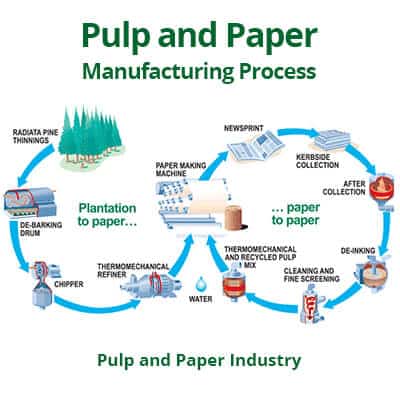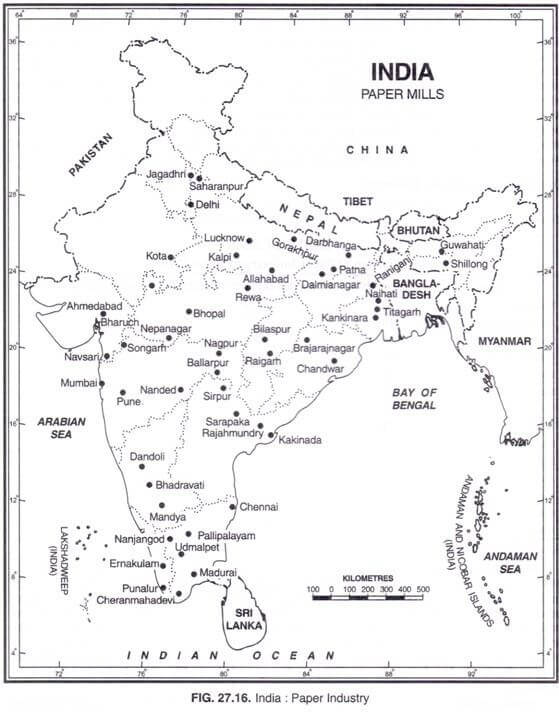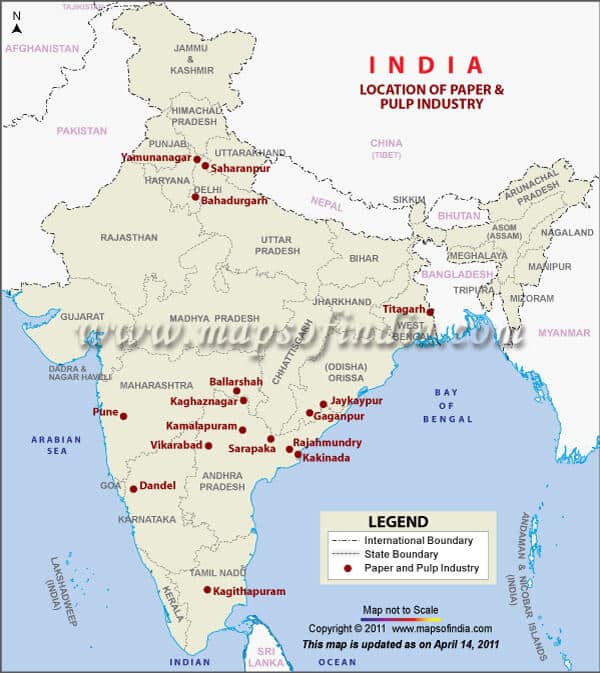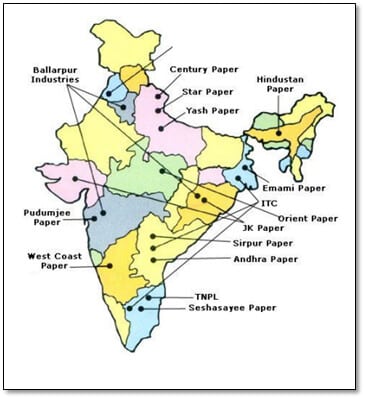In this article, You will read the Paper Industry Growth, development, and Location factors – for UPSC.
Paper Industry
The pulp and paper industry comprises companies that use wood as raw material and produce pulp, paper, paperboard, and other cellulose-based products.
The pulp and paper industry is one of the largest industries in the world. It is dominated by North American, Northern European, and East Asian countries. Latin America and Australasia also have significant pulp and paper industries.
Over the next few years, it is expected that both India and China will become the key countries in the industry’s growth. World production of paper and paperboard is around 390 million tonnes and is expected to reach 490 million tonnes by 2020. In 2009, the total global consumption of paper was 371 million tonnes.
The Paper industry is a vital and core industry for any country and the per capita paper consumption can be taken as a measure of growth and progress in areas related to industrial culture and education activities. Per capita consumption is tending to be stagnant in India at approximately 2 kg as against more than 200 kg in highly developed countries.
Growth and development
- Though the art of papermaking was introduced in India by Muslim rulers during the 10th century, it was flourishing as a cottage industry only.
- The first modern paper mill of course was established in 1832 at Serampore (West Bengal) which could not survive and the industry made a beginning again in 1870 at Ballygaunj ( Royal Bengal paper mills) near Calcutta.
- Many mills thereafter were started at Serampur (W.B), Lucknow (U.P), Titagarh (W.B), Deccan paper mills (Pune), Bengal paper mills (Raniganj), and Indian paper pulp (Shyam Nagar). But progress was sluggish till independence.
- During the period of planned development since independence, the paper industry has made rapid progress.
- In 1950-51 there were 17 units which produced 0.16 million tonnes of paper and 0.9 million tonnes of paper was imported.
- At present, there are more than 30 small and medium paper mills with a capacity of 18.38 lakh tonnes. At present, there are 43 large integrated pulp & paper mills. Besides these, more than 300 small & medium paper mills with a capacity of around 20 lakh tones are also working.
- The small sector accounts for 50% of the installed capacity and of production of paper in the country. In the early 1970s when the country was faced with paper famine, the government came to appreciate the role of the small paper units cause of the short gestation period, the use of cheap second-hand machinery readily available in foreign countries, the use of non-conventional raw materials such as rice and wheat straw, bagasse, jute stalks paper. The small units could be set up in any part of the country.
- The government gave necessary fillip and encouragement to the paper sector and liberal incentives were provided to paper units. The small paper units went into production and adverted the paper crisis.
- Production of paper falls short of our demand and hence large quantities of paper board, better quality paper (insulation paper, parchment paper, tissue paper, etc) have to be imported from Sweden, Canada, Japan, France, Belgium, U.S.A. Paper pulp and west paper are also imported for use as raw materials.
- Some quantities of printing and writing paper, craft and paper board, packing and wrapping paper is also exported to countries of the Middle East, East Africa, and South East Asia.
Paper industry: Growth Pattern
- Since paper can be manufactured using a variety of raw materials, the growth pattern of the industry is sporadic, which is mainly due to:
- Large integrated paper mills.
- Small paper mills based on non-conventional raw materials like bagasse, or in combination with pulp.
- Small units based on waste paper.
- Units as part of large integrated sugar complexes.
- Large integrated newsprint manufacturing units.
- Handmade paper units under KVIC.
Location factors
- The main factors that determine the location of the paper industry are:-
- Nearness to the source of raw material: The location of the paper industry is dependent on the availability of bamboo, softwood. E.g. South Gujarat, Odisha, Madhya Pradesh
- Supply of abundant coal: Energy requirement and total transport cost of coal offset the disadvantage of the dearth of raw materials. Paper manufacturing started in Bengal due to the availability of coal.
- Nearness to the market: Some of the paper mills are located near the market where cheap labour is also available. For example, in Kolkata where raw material is brought from the North Eastern States. Here cheap labour, coal, water is readily available.
- Water Supply: The paper/pulp mills require clean water free from chemicals/pollutants. This is one of the reason why they are set up near forest locations away from polluted rivers.
Manufacturing
- Paper is manufactured in 2 stages in India:
- First Stage: Pulp is extracted from cellulose raw material: In 1st stage gross raw materials is required due to which pulp manufacturing units are located in the midst of cellulose producing areas.
- Second Stage: Pulp is pressed to from paper: In 2nd stage pulp is the raw material and therefore, paper units can be located near urban markets.
- Pulp is drawn from variety of sources like wood, bamboo, sabai/salai grass, bagasse, and crop straw. Hence paper industry is widely distributed across different regions in India.

Raw materials for manufacturing paper
- Bamboo
- Generally speaking 2.3 to 2.4 tonnes of bamboo is required for producing one tonne of paper. The paper industry uses bamboo to the extent of 60-70 percent of the total requirements of cellulosic raw materials. Bamboo has the advantage of possessing long fiber, dense stands, and quick regeneration.
- It reaches maturity in 2-3 years and provides a continuous flow of renewable sources of raw material.
- However, there is a danger of this source of important raw material being depleted if the rate of exploitation exceeds the rate of regeneration. The total supply of bamboo at the current rate is estimated at 20-30 lakh tonnes per annum.
- Assam, Orissa, Andhra Pradesh, Madhya Pradesh, Tamil Nadu, Karnataka, and Maharashtra are important producers of bamboo.
- Sabai grass
- This is another important raw material for manufacturing paper. It was the sole raw material before the introduction of bamboo as a significant raw material, but its use has decreased considerably since then. It now constitutes 7 to 9 percent of the total cellulosic raw material in the country.
- Although Sabai grass has long fiber and requires low chemical consumption, it grows in tufts intermixed with other vegetation and it is often difficult to separate impurities from it.
- Moreover, its supplies are much less than those of bamboo. The annual supply of Sabai grass along with other allied grasses is about one million tonnes. It mainly grows in the sub-Himalayan tracts of the Shiwaliks and the Tarai area.
- Bagasse
- It is a fibrous residue of the sugarcane stalk, mainly from the sugar mills, obtained after sucrose is extracted by crushing the sugarcane.
- On an average 50-60 lakh tonne of bagasse is produced in the country, half of which is used for manufacturing paper.
- Salia wood: It is widely used in the manufacture of newsprint paper.
- Others
- Paper is also manufactured by using materials other than those mentioned above. These include waste paper, rags, straw from rice and wheat, jute sticks, and soft wood obtained from eucalyptus, pine-wood, wattle, and mulberry trees.
Paper industry: Some other facts
- For producing one tonne of paper nearly 2.5 ton of bamboo and about 4 ton of coal are required. Both these materials are heavy as well as weight loosing. The location of industry should be advantageous to both.
- In the beginning when sabai and other grasses were largely used for making paper, it had to be carried to long distance to Bengal units from UP, Punjab, Bihar and Nepal. As coal mines were in Bengal, the mills were located here despite of its unfavourable position.
- In regard to source of raw materials, the Hoogly revering regime was preferred for location of earlier mills for two significant reasons viz.
- The availability of coal in large quantity
- The proximity of large market for the finished product.
- But now with the introduction of bamboo for making paper, Bengal does posses a favourable position for paper industry, from now not only large supplies of bamboo are available in the neighbourhood of the Hoogly riverine tract, but also coal mines and large consuming market exists.
- Some of the south Indian mill in Karnataka and Kerala also use bamboo which grows abundantly there.
- Most of the mills of UP and Haryana depends of sabai grass and murj grass. In UP the paper mills at Lucknow and Saharanpur (using sabai grass) command excellent transport relation in regard to raw materials and markets though in.

Location of Industry
- It is a raw material intensive industry. According to Weber concept, the ratio of raw material and finished product for the paper industry is 4:1 as it is a weight losing industry.
- The material index for it is greater than 1. Hence, in the initial phase, it is advantageous for the industry to be located near the raw material sources.
- Presently more and more plants are using bamboo as raw material. In comparison to sabai grass bamboo possesses certain advantages. Sabai grass is found intermixed with other vegetation and is often difficult to separate impurities from it.
- Further its supplies are so limited and it requires 60 years for regeneration of the forest whereas bamboo is exhausted because of its quick and dense growth and it generates in a year or two.
- Though the quality of paper produced from bamboo lacks in strength, yet bamboo has an advantage over the sabai grass in that, paper can be made entirely from bamboo without any admixture of wood pulp, the paper made from bamboo cannot be used for painting and for writing.
- Recent discovery of method for manufacturing paper from hard wood has made a revolution. Now mills have therefore been set up in M.P to utilize the hard wood.
- The newsprint mill in M.P at Nepanagar uses sabai wood for making paper pulp and also uses imported pulp from Canada and Scandavian countries. Hardwood (as in M.P), West Bengal, West Coast of India and temperate wood in the Himalaya region, J & K also provide potentialities for paper facture.
- Thus as the raw materials and chemicals are available in most of the areas around the country, all the paper mills are dispersed in locations.

Distribution
- Among the paper-producing states of India, West Bengal, Orissa Madhya Pradesh, Andhra Pradesh, Maharashtra and Karnataka constitute nearly 65% of the total production capacity. Other important producers are Tamil Nadu, Kerala, Assam, Haryana, Bihar and Gujarat. According to the estimates available, Assam possesses greatest potential to develop paper industry because of the presence of large forests as raw material.
- State-wise distribution of paper mills are:
- West Bengal: Since early eighteenth century, West Bengal contributed substantially to the national paper output. Major Mills in the state are situated along Hooghly River. The important mills of the state are Calcutta, Tribeni, Titagarh, Alambazar, Kakinara, Bansberia, Baranagar and Ranigunj. Some of these mills use waste paper and agro-residues as raw material; others use sabai grass and eucalyptus tree as raw material.
- Orissa: As a producer of paper, Orissa is gradually improving her position. Right now, three mills are producing paper at Brajarajnagar, Rayagada and Chowdwar. This state possesses wonderful assemblage of vast forest resources and cheap hydel power.
- Madhya Pradesh: A good number of new paper mills were set up within Madhya Pradesh in recent years. Major Mills are located at Nepanagar, Vidisha, Rewa, Ratlam, Shahdol etc. Nepa Nagar is the only newsprint manufacturing unit in the country.
- Andhra Pradesh: Abundance of bamboo and incentives declared by the state government attracted number of paper manufacturing units in Andhra Pradesh. All the mills are new, with sophisticated machines. Major Mills are situated at Rajamundry, Kagaznagar, Bodhan and Bhadrachalam.
- Maharashtra: At least 15 mills are located within the state. Mills are located at Kalyan, Khopli, Ballarpur, Pune, Nagpur, Bhiwandi, Bombay and Kamptee etc. Most of these mills are old and worn out.
- Karnataka: Leading paper manufacturing units in the state are Bhadravati, Belagola, Dandeli, Ramanagram, Bangalore, Krishnaraj Sagar.
- Tamil Nadu: Tamil Nadu has 24 small sized mills accounting for 5.74 per cent of the total installed capacity of the country. These mills use locally grown bamboo. Cheranmahadevi, Pallipalayam, Udmalpet, Chennai, Salem, Amravathinagar, Pahanasam, Madurai, etc. are the major producers.
- Uttar Pradesh: This state has the largest number of 68 mills, but the size of the mills being small, the installed capacity does not exceed 9 per cent. Saharanpur and Lalkuan have mills of large size. The other centres are at Meerut, Modinagar, Ghaziabad, Lucknow, Gorakhpur, Pipraich, Muzaffamagar, Allahabad (Naini), Varanasi, Kalpi, Budaun and Mainpuri.

Problems of the industry
- Shortage of raw material:
- Sabai grass and Bamboo supply is often interrupted by various reasons. No industry has created its own plantation through which it could own raw material demand.
- With the dwindling forest wealth in India, there is a serious shortage of raw materials to meet the needs of paper industry. Use of unconventional raw materials (like eucalyptus, wheat bran, rice straw) also demands new process developments, installation of new processing & control equipment.
- High cost of production:
- The international price of capital equipments needed for paper industry is very high. In the last decade, the cost of power and coal has increased by 400 units, royalties on bamboo and hardwood has been increased by 70% and faces heavy transport cost due to bulkiness of the raw material.
- Problems of Royalties and lease:
- Many governments started raising their royalties from forest land leased to paper mills to meet their current expenditure. Some state governments have raised the royalty rates to 5-6 times in a short period of 5 to 6 years. Such policies towards royalties and the terms of lease are extremely unsatisfactory. The policy should be stable and based on long term basis.
- Over capacity and under utilization:
- Active encouragement by government has resulted in over capacity in the industry.
- Between 1974 and 1984, 180 mills are set UP in the country thus creating excess capacity. Even when capacity utilization is high 72% in recent years, 7 large units & 13 small paper units have been idle for year.
- Sickness in small paper units:
- High cost of investment & low rate of realization is one of the major reasons for sickness of small units. Further, heavy burden towards investment, financial institutions and markets have aggravate the problem.
- Non–availability of coal and raw materials, rise in electricity & water charges are the other major hurdles in the growth of this industry. Owing to these reasons, they could not compete with large paper units.
- Disposal of Effluents:
- Disposal of effluents is a great problem. Suitable processing technique is not available for small units. So they were forced to close.
- Lack of research:
- There is a need to develop new processes for the utilization of raw materials, developing the different grades of suitable pulp, designing and engineering of suitable equipment.
- In order to meet the demand, the industry need to look for unconventional raw material but this need new advanced technology which a developed country like India cannot afford.
- Eco–conservation – The growing consciousness for preservation of forests and maintenance of ecological balance and biodiversity has further reduced the availability of raw material. Moreover the environmentalists are up in arms against this industry due to effluents thrown by the paper mills into open drains, rivers and rivulets there by polluting the environment.
- Increasing demand – At the present low rate of consumption i.e. about 17% of world population constituted by India consumes only 2.5% of the world paper and paper board. India is facing wide gap between supply and demand of paper. Now with spread of education and literacy demand for paper is bound to increase and is expected to double in next 10 years.
- Average size of paper mills is abnormally own at less than 10000 tones as against 50,000 tonnes in south East Asia & 85,000 tonnes in Asia-pacific.
- Only 15% of total output of paper & paper board is based on recycled material against the world average of 30-85%. Thus there is a vast scope for using recycled material in paper industry, currently India has over 16% of world’s population but consumes a meagre 1% of worlds paper & paper board. With the spread of education & literacy the demand of the paper is bound to increase.
Future prospects and suggestions
- To overcome the problem of raw materials, various methods have been adopted such as:
- Shift in raw materials from bamboo to eucalyptus, wattle, mulberry wood
- To recycle the fiber and making paper production environment friendly.
- Move overthrust on social & farm forestry has started to ease the raw material availability.
- As bamboo cultivation has become uneconomical, reliance has been placed on unconventional raw materials. Paper mills have to undertake plantation forestry in their surrounding areas.
- Indian paper industry is placed in and better position compared to industry leaders in the west in two ways:
- Growth cycle of tropical plantations takes 6-7 years whereas conifers (in the west) take nearly 50 years to grow.
- Low wage structure in India.
- The Indian paper industry has trained manpower at all levels & hence it can produce good quality paper with appropriate technology at relatively low manpower cost.
- But for the improvement of the paper industry, technology modernization is a must. However, it requires a huge capital investment on part of private players which is not always easy to avail.
- Bagasse- Judicious use of bagasse should be encouraged as the large quantity of bagasse is used as fuel in the sugar industry and is not made available to the paper industry. Sugar mills need to be encouraged to use coal-fired boilers instead of those based on bagasse. India being the largest producer of sugarcane holds huge potential in this regard.
Advantages of the Indian paper industry
- As compared to the western countries growth cycle of Indian tropical forests is 6 to 7 years whereas the growth of conifers of the west requires 50 years.
- Labour is cheap in India as compared to the Western world. Besides that Indian manpower of this industry is well trained and produces good quality paper with relatively low manpower cost.

Superbly amazing analysis of paper industry in India 🙏
Keep reading & Happy Learning.
geography will become easy subject when you visit lotus arise